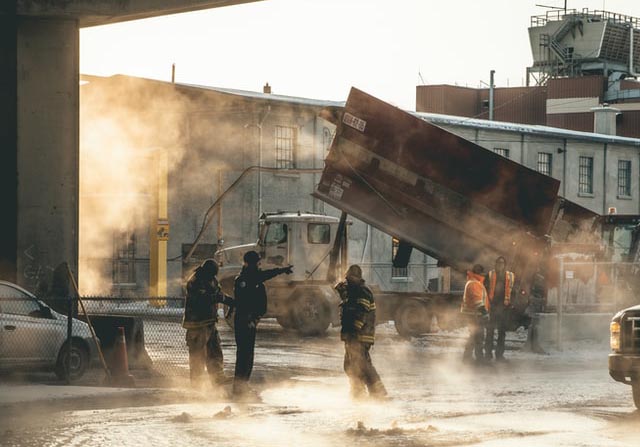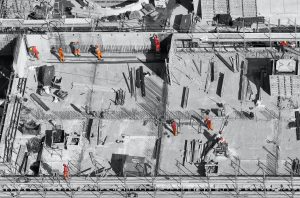Achini Shanika Weerasinghe and Thanuja Ramachandra
Department of Building Economics, University of Moratuwa
Abstract
Buildings should be visualized for running costs, which entails a number of key cost components including operation and occupancy costs, and maintenance costs (renewal plus maintain) at the early stage of their life cycle. Hence, the information on different cost elements of running costs and their contributions would be helpful for effective decision making at the design stage. This research analyses the constitution and contribution of running costs of commercial buildings in Sri Lanka. The research was approached quantitatively where the costs data were extracted from financial documents of eight buildings according to standard cost classification systems of Building Maintenance Cost Information Service (BMCIS). The results show that the utility and administrative costs range between 29-38%, taxes and subsidies vary between 6-16%, the cost of cleaning contributes 10%, building services maintenance contributes 6-9%, general maintenance varies between 6-9%, and the insurance and external works range less than 1% of total running costs. So what? You need to write here the implication of this findings
Keywords: Commercial Buildings; Running Costs; Operational and Maintenance costs, Sri Lanka.
Introduction
Often, the building designs are evaluated purely based on the initial costs. This tends to accept the cheapest initial costs by building owners and then hand over to occupiers to maintain the building. However, the reduction of capital cost leads to expensive maintenance, operation, and disposal costs in buildings (Kehily, 2010). Moreover, the occupiers would reject higher rent unless lower operating expenses offset it. Therefore, higher capital cost should be reflected in lower operating and maintenance costs (Korpi & Ala-Risku, 2008). Running costs can be defined as the sum of maintenance and operating costs, which are incurred during the use phase of the building (Al-Hajj & Horner, 1998). A wide range of operations and maintenance activities are possible, which have different costs of the ongoing performance and future replacement cycles of a constructed asset (Arditi & Nawakorawit, 1999).
A study for maintenance projects using the performance approach can provide opportunities to improve cost, risk and quality management of the properties concerned in the long run (Joseph, 2010). Recent research efforts have been put on the study of operation and maintenance in buildings. For example, Building operation and maintenance accounts for over 50% of the total building costs of the building industry (Woodward, 1997). Further, a recent study, Wong et al. (2010) indicated that the 72% to 81% of total life cycle cost (LCC) of commercial building category is committed for operation and maintenance. In another word, over 70% of the total LCC of a building incurs during its in-use phase. The annual electricity consumption of a typical commercial building consists of 43% of energy for air conditioning, 17% is for office equipment, 6% for lifts and escalators, and another 34% for lighting (Yu & Chow, 2001). Lai and Yik (2008) introduced some useful benchmarks of operation and maintenance costs of luxury hotels. Those benchmarks are, the average major operation and maintenance cost expenditures consume 34% for electricity, 23% for capital projects, 19% for repair and maintenance, 13% of operation and maintenance staff, 5% of town gas, 4% for diesel oil and 2% for water. Lai and Yik (2011) discovered that the average operation and maintenance costs in French healthcare facilities cater to 23-34% of the total costs. Moreover, they introduced a benchmark to evaluate and develop operational strategies for health facilities in France.
The forgoing review indicates the importance of accounting the running costs of buildings and the changes in its constituents to different context. Accordingly, this research aims to analyse the constitution and contribution of running costs of commercial buildings in Sri Lanka towards an effective decision making on running costs of commercial buildings at the early stage of building life-cycle.
Literature Review
Running Costs of Commercial Buildings
A commercial building includes office, industrial property, retails, hotel facilities, healthcare, and residential buildings (Aye, Bamford, Charters & Robinson, 2000). When considering the different types of buildings, commercial buildings contribute significantly to resource consumption through building operations and maintenance globally and nationally (Scheuer, Keoleian, & Reppe, 2003). Most of the commercial buildings have similar characteristics such as being a high-rise, air-conditioned by a centralized chiller plant and often used for multiple usages including offices, retailing shops and restaurants (Yu & Chow, 2001). Operation and maintenance costs in commercial buildings similar to any kind of building, compromise with energy and utilities, maintenance, repair, decoration, refurbishment costs, etc. (Yu & Chow, 2001). Several research efforts have put on the study of operation and maintenance costs of buildings. Woodward (1997) indicated that the operation and maintenance costs account for approximately 55% of the total costs over a building’s lifespan of 40 years. Later, Lai and Yik (2008) introduced some useful benchmarks of breakdown operation and maintenance costs for luxury hotels, the average major operation and maintenance costs expenditures consume 34% for electricity, 23% for capital projects, 19% for repair and maintenance, 13% of operation and maintenance staff, 5% of town gas, 4% for diesel oil and 2% for water. Subsequently, the same authors (2011) discovered that the average operation and maintenance costs in French healthcare facilities cater to 34% to 23% of the total costs. In the recent past, the Building Owners and Managers Association (BOMA) International and Kingsley Associates (2017) has released a breakdown of operating expenses within the commercial buildings based in the USA as demonstrated in Figure 1.
Figure 1: Operations and Maintenance costs breakdown of a typical commercial building.
(Source: BOMA, 2017)
As shown in Figure 1, 82% of the operating costs of a typical commercial building is incurred by utilities (25%), repairs and maintenance (23%), cleaning (17%), and administrative work (17%).
The energy consumptions of the commercial buildings in Sri Lanka are high, in terms of electricity (De Silva, 2011). When considered the electricity energy balance of a typical building in Sri Lanka more than 75% may be created by air conditioning systems (Sri Lanka Sustainable Energy Authority [SLSEA], 2014). In Sri Lanka, most commercial and state sector buildings are in Colombo city limits, which have the hottest and a more humid climate. Therefore, air conditioning is one of the main requirements to maintain a comfortable indoor climate. On the other hand, Sri Lanka experiences a considerable rise in electricity tariff rates annually and the national demand for electricity for air conditioning has been increasing over the years (Athukorala et al., 2013).
In the context of Sri Lanka, the operation and maintenance support costs are viewed within a limited range where the energy cost is in primary concern. For example, it has been estimated that the use of energy is 20%-60% of the annual operations and maintenance costs of office buildings (Weddikkara, 2001). Further, the electricity consumption in office buildings accounts for 20% of the total electricity consumption in Sri Lanka (SLSEA, 2014). The above findings highlight that the electricity cost consumes a greater share of operational costs in commercial buildings in Sri Lanka due to the operation of building services such as heating, ventilation, and air conditioning (HVAC). However, the records of the maintenance costs of commercial buildings are limited. Therefore, there seems a lack of estimations for the total running costs of commercial buildings in Sri Lanka. To this end, as part of the larger study which focuses on developing a running cost model based on building characteristics and running cost indices, this paper presents an analysis of the running cost of commercial buildings towards identifying its constituents and contribution.
Research Methods
The research was undertaken using the quantitative approach where the running costs data were extracted from financial documents of eight (08) commercial buildings in Sri Lanka. Running costs data were collected according to a standard structure that is developed based on the Building Maintenance Cost Information Service (BMCIS) framework (Ref). The modified cost categories considered rent, utilities, insurance, administrative cost, and taxes and subsidies as elements of operational costs while decoration, fabric, services, cleaning, external works, and replacements of major components consist of maintenance costs. The running costs data, operating and physical characteristics of buildings were extracted from documents such as organizational annual reports, administrative expenditure budget records, operating expenses reports and as-built drawings of the selected buildings. Physical data collected included: building floor area, height, and the number of floors. Descriptive statistical analysis was used to analyze the running costs data after separating the data into projects with similar characteristics.
Data Analysis And Findings
Profile of the Selected Buildings
Selected buildings belonged to different sectors of industries such as property development sector, commercial banking, mixed development, financial sector, customs administration, and commercial office. Table 1 presents the profile of the selected buildings.
Table 1: Profile of Buildings
| Building | Type of the Organization | Type of Function | No of Floors | Expected Life Span of the Building (Years) | Years in Operation |
| B1 | Banking industry | Merchant banking, property development, and management, renting of office space | 32 | 50 | 30 |
| B2 | Institution in financial sector | Provide intermediation to distribute financial resources | 16 | 50 | 15 |
| B3 | Customs administration | Controlling and monitoring imports and exports of restricted and prohibited goods | 13 | 50 | 4 |
| B4 | Property development and management | Provide rentable office and business space with modern infrastructure facilities | 37 | 50 | 20 |
| B5 | Banking industry | Commercial banking, project lending, and development banking | 23 | 100 | 13 |
| B6 | Mixed development | Provide apartments, provide space for events and functions | 34 | 50 | 18 |
| B7 | Commercial office | Management and operation of hotels and resorts | 13 | 50 | 21 |
| B8 | Property development and management | Leasing of office space and real estate | 17 | 50 | 19 |
The Constitution of the Running costs in Commercial Buildings in Sri Lanka
The running costs of commercial buildings were analysed according to standard cost classification system of BMCIS. The given framework includes the operation costs elements such as rent cost, insurance cost, utility costs, administrative costs and taxes. But, when considering the selected cases, all the selected commercial buildings are owned by the respective organizations that operate and occupy the premises. Most of those buildings own rentable spaces which make rental as an income for the organization. Hence, rent cost is not identified as an element of running costs in commercial buildings in Sri Lanka.
The insurance cost is mainly determined through a certain package of insurance and this may depend on the reinstatement value of the property including plant and machinery. Under the utility costs, costs for electricity, water, fuel, and effluent and drainage are mainly identified. Those costs are separately maintained in the selected cases. The administrative costs of commercial buildings mainly consist of staff costs, waste disposal, security costs, sundries, and porterage. But, an additional cost may incur for property management if the buildings are managed by outsources companies such as property management companies or facilities management firms. Other than that, taxes and subsidies are engaged with any kind of commercial building.
Maintenance costs elements included in the prepared framework are the cost for the decoration, fabric maintenance, building services maintenance, external works, cleaning, and replacement of major systems and components. Basically, decoration includes the cyclical and non-programmed internal and external decorations. And the fabric maintenance and building services are considered as a combination of planned maintenance, corrective maintenance, deferred maintenance (emergency) and repairs and replacement of minor components of those elements.
As identified in the data collection, the cost for the decoration and fabric maintenance has not been maintained separately in commercial buildings in Sri Lanka but, added as a cost for the general building maintenance. Maintenance costs for the building services are separately maintained in commercial buildings in Sri Lanka, according to the types of building services which the commercial buildings are capable of. Moreover, the external works include both the cost of pest controlling and landscaping and separately maintain those costs in commercial buildings. The cost of the cleaning mainly considered as the cost of housekeeping. The replacement of major systems and components comes under the building services maintenance. Basically, those cost elements are categorized as being easy for accounting purposes.
The Contribution of the Running costs in Commercial Buildings in Sri Lanka
A significant difference was observed between maximum and minimum values of the running cost of selected buildings. Hence, it was not accurate if considered the mean value of the sample to analyze the running costs of commercial buildings in Sri Lanka. Therefore, the median value of the sample is considered. The difference between the median and the actual running cost of each building was calculated and considered to select the best samples to illustrate the composition of running costs.
Table 2: Median running costs to % Deviation in Running Costs of Each Case
| Element | % Deviation of Running Costs compared to Median | |||||||
| B1 | B2 | B3 | B4 | B5 | B6 | B7 | B8 | |
| Running costs | -120% | 7% | -7% | -15% | -91% | 69% | 75% | 68% |
As seen in Table 2, there are three different ranges of cost deviations found among selected buildings. The running cost deviation of B2, B3 and B4 ranges around ±10% on average, while the deviation of B6, B7, and B8 ranges between 70 – 75%. The buildings B1 and B5 indicated an extremely high deviation, compared to the running cost of other buildings and ranges around -100% on average. Further, the physical characteristics of the selected buildings are considered, amongst selected buildings, B1 consists of the highest number of floors and the largest gross floor area (refer to Table 1). Therefore, the buildings, B2, B3, and B4 were classified as category 1, while B6, B7, and B8 were classified as category 2 and considered for further analysis. The buildings, B1 and B7 were eliminated from the analysis due to major deviations. Table 3 shows the classified buildings with its description.
Table 3: Scope of Data Used for the Descriptive Analysis
| Classification of Buildings | Description | Buildings Selected |
| Category 1 | Commercial high-rise building, having 23 to 34 floors | B2, B3, and B4 |
| Category 2 | Commercial high rise building which are having 13 to 17 floors | B6, B7, and B8 |
Table, 4 indicates the contribution of each element to the total running cost which is derived by the mean value of the cost elements.
Table 4: Contribution of Each Element to the Running costs
| Element | Category 1 | Category 2 | ||
| Mean Value (LKR) | Contribution to Running costs % | Mean Value (LKR) | Contribution to Running costs % | |
| 1) Running costs | 397,003,755 | 110,718,240 | ||
| 1.1) Operation Cost | 296,590,098 | 74.71 | 82,623,354 | 74.62 |
| 1.1.1) Insurance cost | 4,255,343 | 1.07 | 1,661,413 | 1.50 |
| 1.1.2) Utilities | 115,007,740 | 28.97 | 42,273,008 | 38.18 |
| 1.1.3) Administrative cost | 114,587,513 | 28.86 | 38,117,559 | 34.43 |
| 1.1.4) Taxes and Subsidies | 62,739,502 | 15.80 | 6,197,041 | 5.60 |
| 1.2) Maintenance Cost | 100,413,657 | 25.29 | 28,094,886 | 25.38 |
| 1.2.1) General Building Maintenance | 24,383,333 | 6.14 | 9,866,265 | 8.91 |
| 1.2.2) Building Services | 32,506,575 | 8.19 | 6,756,218 | 6.10 |
| 1.2.3) Cleaning | 42,671,016 | 10.75 | 10,857,509 | 9.81 |
| 1.2.4) External Works | 852,733 | 0.21 | 614,894 | 0.56 |
On closer scrutiny, Figure 2 depicts the composition of running costs of the selected two categories of commercial buildings.
Figure 2: Contribution of Each Element to the Total Running costs
As seen in Figure 2, the running cost consists of operational and maintenance costs. For both categories of buildings, the % contribution of operational and maintenance costs to the running cost is equal, 75% and 25% respectively. As per the results of two categories, the contribution of utility costs varies from 29-38%, administrative costs range from 29-34%, taxes and subsidies range from 6-16%, cost for the cleaning range from 10-11%, cost for the building services maintenance range from 6-8%, general building maintenance vary from 6-9%, and the insurance and external works range below the 1%. In both categories of building, utilities and administrative costs are highly contributing elements to the total running cost with a 30-40% contribution. Amongst the utility cost, the electricity cost consumes a higher proportion than the other energy costs such as fuel, gas, and water, where the electricity cost ranges between 87-94% of utilities. The administrative cost, on the other hand, includes a higher proportion of staff cost than the other administrative costs such as property management, sundries, porterage, and waste disposal costs.
Conclusions
In the context of Sri Lanka, the commercial building sector has more focused on identifying, collecting, analyzing and reviewing information related to the utility costs and mostly the electricity costs due to the prevailing energy crisis globally. Nevertheless, this does not visualize the attempts towards tracking the running costs of the commercial buildings in Sri Lanka for effective decision making during the early stages of building life-cycle. Therefore, the current study identified the main cost elements of commercial buildings that are insurance, utilities, administrative, taxes and subsidies, general building maintenance, building services maintenance, cleaning, and external works. The study further estimated the contribution of each cost element to the total running cost. Accordingly, the contribution of utility costs varies from 29-38%, administrative costs range from 29- 34%, taxes and subsidies range from 6-16%, cost for the cleaning is between 10-11%, cost for the building services maintenance ranges from 6-8%, general building maintenance varies from 6-9%, and the insurance and external works range below the 1%. Therefore, the current analysis of running costs of commercial buildings provides effective decision making concerned in the long run.
References
Arditi, D. and Nawakorawit, M., 1999. Issues in building maintenance: property managers’ perspective. Journal of Architectural Engineering, 5(4), 117-132.
Athukorala, N., Sarathchandra, P. D. and Chiu, J., 2013. A feasibility study on absorption cooling based thermal energy storage. SLEMA Journal, 16(1), 6-14.
Aye, L., Bamford, N., Charters, B. and Robinson, J., 2000. Environmentally sustainable development: a life-cycle costing approach for a commercial office building in Melbourne, Australia. Construction Management and Economics, 18(8), 927-934.
BOMA and Kingsley Associates, 2017. 2017 Office Experience Exchange Report. Washington: BOMA International.
Building Maintenance Cost Information Service, 1984. Standard form of property occupancy cost analysis: principles, instructions, definitions and elements. London: Connelly-Manton.
De Silva, M., 2011. Developing a framework to benchmark operational energy for sustainable commercial buildings in Sri Lanka. Thesis (BSc). University of Moratuwa.
Flanagan, R., Kendell, A., Norman, G. and Robinson, G. D., 1987. Life cycle costing and risk management. Construction Management and Economics, 5, 53-71.
Joseph, H. L., 2010. Building operation and maintenance: education needs in Hong Kong. Facilities, 28(9/10), 475 – 493.
Kehily, D., 2010. Guide to life cycle costing. Ireland: Society of chartered surveyors.
Korpi, E. and Ala-Risku, T., 2008. Life cycle costing: a review of published case studies. Managerial Auditing Journal, 23(3), 240-261.
Lai, J. H. and Yik, F. W., 2008. Benchmarking operation and maintenance costs of luxury hotels. Journal of Facilities Management, 6(4), 279-289.
Lai, J. H. and Yik, F. W., 2011. Benchmarking operation and maintenance costs of French healthcare facilities. Journal of Facilities Management, 9(4), 266-281.
Lam, E. W., Chan, A. P. and Chan, D. W., 2010. Benchmarking success of building maintenance projects. Facilities, 28(5/6), 290-305.
Scheuer, C., Keoleian, G. A. and Reppe, P., 2003. Life cycle energy and environmental performance of a new university building: modeling challenges and design implications. Energy and Buildings, 35, 1049-1064.
Sri Lanka Sustainable Energy Authority, 2014. Electricity: Sri Lanka energy balance [Online]. Available from: http://www.info.energy.gov.lk/ [Accessed 10 March 2015].
Weddikkara, C., 2001. Towards sustainable development – an overview. Financial Times.
Woodward, D. G. 1997. Life cycle costing- theory, information acquisition and application. International Journal of Project Management, 15(6), 335-344.
Yu, P. C. and Chow, W. K. 2001. Energy use in commercial buildings in Hong Kong. Applied Energy, 69, 243–255.




